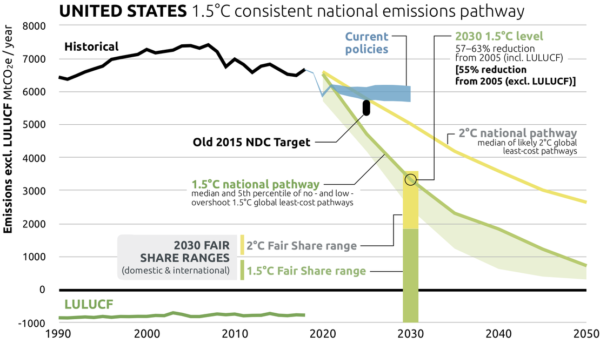1.5°C-consistent benchmarks for the US 2030 climate target
Authors
Bill Hare, Claire Stockwell, New Climate Institute

After officially rejoining the Paris Agreement, the Biden administration is now preparing a new 2030 Paris Agreement target – or Nationally Determined Contribution (NDC) that is expected to be announced in time for the Leaders’ Climate Summit on Earth Day (22 April).
The CAT’s analysis indicates that the new US NDC should aim to reduce its national emissions by at least 57-63% below 2005 levels by 2030 (incl. LULUCF) and provide support to other countries in order to be consistent with the Paris Agreement 1.5°C limit.

The CAT analysis looks at President Biden’s plans for three sectors and compares them with benchmarks defined in its benchmarks report:
- Decarbonising the US power sector by 2035 is consistent with a Paris Agreement pathway;
- For the transport sector, the largest source of emissions in the US, there is still a long way to go. While President Biden has begun the process toward clean passenger vehicles, he has set no targets nor timelines. The CAT analysis shows that to be compatible with the Paris Agreement 1.5 ̊C temperature limit, 95%-100% of sales of new light-duty vehicles in the US should be zero-emissions at national level by 2030. Progress has been made in states (such as California) and by automakers, but needs to be taken nationwide;
- For the buildings sector, President Biden plans to reduce the carbon footprint of the US buildings sector by 50% by 2035. However, to be Paris Agreement compatible, the CAT analysis indicates that by 2030, emissions in the US buildings sector should be around 60% lower in residential buildings, and 70% lower in commercial buildings (from 2015 levels).











